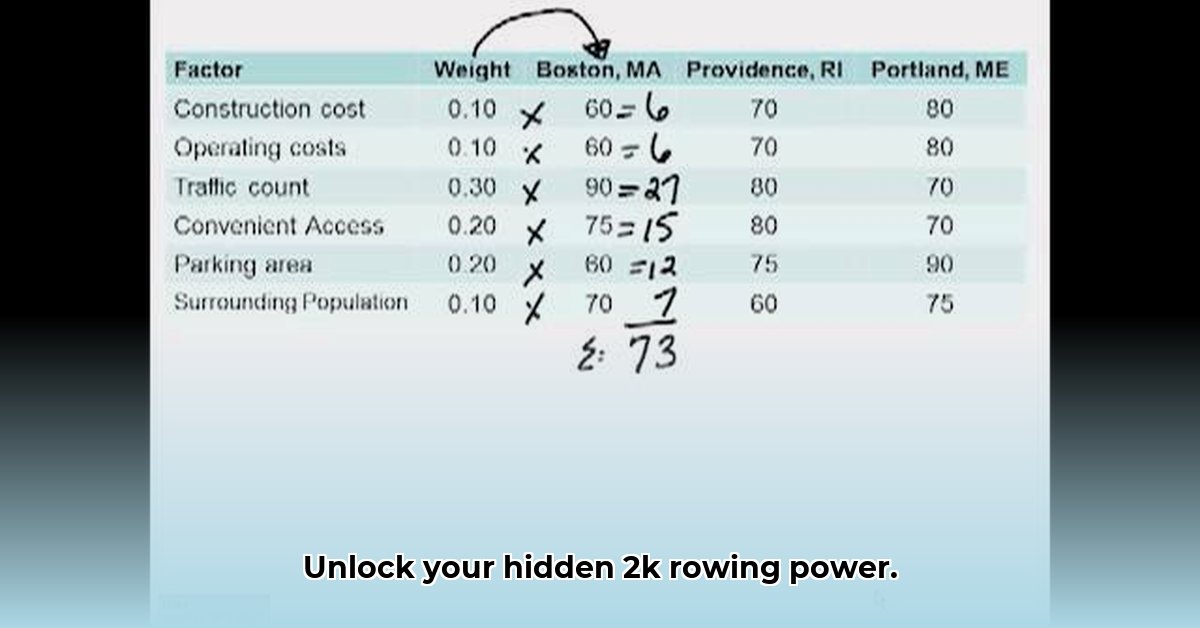
Weight-Adjusted 2k: A Fairer Comparison?
Heavier rowers often achieve faster raw 2k times on the ergometer (rowing machine). But does this truly reflect their relative speed and power? The weight-adjusted 2k score aims to provide a more equitable comparison between rowers of different weights, offering insights into performance beyond simple raw numbers. However, understanding its limitations is crucial for proper interpretation.
Calculating Your Weight-Adjusted 2k Score
The calculation, based on a formula developed by Concept2 1, is surprisingly straightforward. Let's break it down step-by-step:
Step 1: Determine Your Weight Factor (Wf)
This factor accounts for your body weight. The formula is:
Wf = (your weight in pounds / 270)^0.222
Use a calculator; you'll get a number less than 1.
Step 2: Adjust Your Time
Multiply your actual 2k time (in seconds) by your calculated Wf. The result is your weight-adjusted time.
Step 3: Interpret Your Adjusted Time
A lower weight-adjusted 2k time signifies better relative performance for your weight.
Example: A 160-pound rower with a 7-minute (420-second) 2k time will have a Wf of approximately 0.90. Their adjusted time is 420 seconds * 0.90 = 378 seconds (approximately 6 minutes and 18 seconds).
Understanding the Weight-Adjusted 2k: Strengths and Weaknesses
While valuable, the weight-adjusted 2k isn't a perfect measure of rowing prowess.
Advantages:
- Fairer Comparisons: Allows for more objective comparisons between rowers of varying weights.
- Progress Tracking: Monitors improvement over time, regardless of weight changes.
- Motivational Tool: Provides a quantifiable goal for training.
Limitations:
- Technique Dependency: Assumes consistent rowing technique among all athletes. Superior technique can outweigh weight advantages.
- Ergometer vs. Water: Ergometer performance doesn't perfectly translate to on-water results due to environmental factors. The adjusted score might be more useful when comparing different erg scores than when predicting actual on-water success.
- Baseline Limitations: The formula uses 270 pounds as a standard weight, a value that some researchers suggest requires periodic adjustment.
Maximizing the Value of Your Weight-Adjusted 2k Score
To effectively utilize weight-adjusted 2k scores:
- Prioritize Personal Progress: Focus on your own improvement over time. Are your adjusted times decreasing? That's a success indicator.
- Integrate with Other Data: Combine the score with physiological data (heart rate, lactate), race results, and coaching feedback for a comprehensive assessment.
- Acknowledge Limitations: Remember, it's an estimate, not a definitive predictor of race performance.
The Future of Weight-Adjusted Scoring
Ongoing research aims to refine weight-adjusted scoring:
- Dynamic Baseline: Adjusting the standard weight to reflect changes in average rower weight over time.
- Incorporating More Metrics: Including parameters like stroke rate and power output for a holistic evaluation.
- Improved On-Water Correlation: Stronger correlation between weight-adjusted 2k scores and on-water performance.
By combining the weight-adjusted 2k score with other data and a nuanced understanding of its limitations, rowers can gain valuable insights to improve their training and performance.